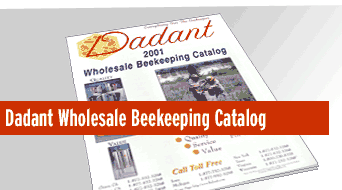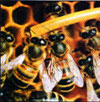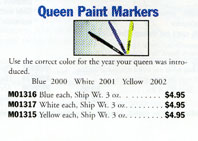
Behind virtually every simple packaged good is an industry filled with its own jargon, its own specialized equipment, its own little set of rules, assumptions, and protocols. Most of us never come into contact with any of this, but every now and then something floats into our field of vision to provide a behind-the-scenes glimpse of the world behind the finished product. Trade magazines are good places to start (I'm particularly fond of Elevator World, Onion Grower, and the magnificent American Funeral Director), and so are trade catalogs, if you're lucky enough to come across them. Happily, a classic example recently landed in my mailbox: the Dadant 2001 Wholesale Beekeeping Catalog.
Unless you've worked in the biz yourself, beekeeping and honey production are almost certainly more complex than you realize, and nothing demonstrates this better than a quick flip through the Dadant catalog, virtually every page of which is brimming with highly specialized equipment -- bee smokers, hive carriers, honeycomb cutters. They've even got those little bear-shaped honey bottles. The best part, as is the case with most wholesale supply catalogs, is that many of Dadant's products are solutions to problems that never would have occurred to most of us in the first place. For example:
 -
Bee Boost ($13.95): Described as "a plastic release device containing
a specific amount of queen mandibular hormone," Bee Boost is basically
a concentrated dose of queen-bee pheromone -- yowza! "Introduced into
a hive or package of bees," says the catalog, "Bee Boost is treated much
like a queen," which apparently comes in handy when shipping queenless
batches of bees, when your hive's queen is temporarily unavailable, or
when you need "to capture straggler bees." Ooh, those pesky straggler
bees!
-
Bee Boost ($13.95): Described as "a plastic release device containing
a specific amount of queen mandibular hormone," Bee Boost is basically
a concentrated dose of queen-bee pheromone -- yowza! "Introduced into
a hive or package of bees," says the catalog, "Bee Boost is treated much
like a queen," which apparently comes in handy when shipping queenless
batches of bees, when your hive's queen is temporarily unavailable, or
when you need "to capture straggler bees." Ooh, those pesky straggler
bees!
 -
Bee brush ($2.95; six or more for $2.75): What's a bee brush for? For
brushing bees, silly. Or, more specifically, "for brushing bees off queen
cells [or] to remove bees from frames, supers or clothes." Granted, I'm
no expert, but with its wooden handle and yellow bristles, this frankly
looks like a very ordinary household brush, but maybe it has some special
bee-related features that aren't apparent to the untrained eye. "Will
not crush or injure bees," says the catalog -- um, wouldn't that be implicit?
-
Bee brush ($2.95; six or more for $2.75): What's a bee brush for? For
brushing bees, silly. Or, more specifically, "for brushing bees off queen
cells [or] to remove bees from frames, supers or clothes." Granted, I'm
no expert, but with its wooden handle and yellow bristles, this frankly
looks like a very ordinary household brush, but maybe it has some special
bee-related features that aren't apparent to the untrained eye. "Will
not crush or injure bees," says the catalog -- um, wouldn't that be implicit?

- Queen paint markers ($4.95 each): If you've ever seen a commercial bee hive at the county fair, you've probably noticed that the queen bee has usually been swabbed with a colored marker so that she can be more easily identified by the beekeepers. But did you know that the industry uses specific marker colors for specific years, depending on when a queen was introduced to her hive? It's true! According the catalog, the proper color for 2000 was blue; this year, it's white. And next year it'll be yellow, which seems rather unimaginative, don't you think? I mean, c'mon, people -- it's a bee, it's already got plenty of yellow!
Dadant has been in the beekeeping supply business since 1863, so they know what they're doing even if I don't. Plus the catalog includes a little "Frequently Asked Questions About Beekeeping" section, my favorite query from which is, "When should I hive my new package of honey bees?" I don't really care about the answer; I just think it's cool to see "hive" used as a verb. With this and other gems lurking in its pages, the Dadant catalog gets my vote for the best subway or bathroom reading of the year so far.
(Dadant & Sons, Inc., 51 S. 2nd St., Hamilton, IL 62341; 800-637-7468; dadant@dadant.com)